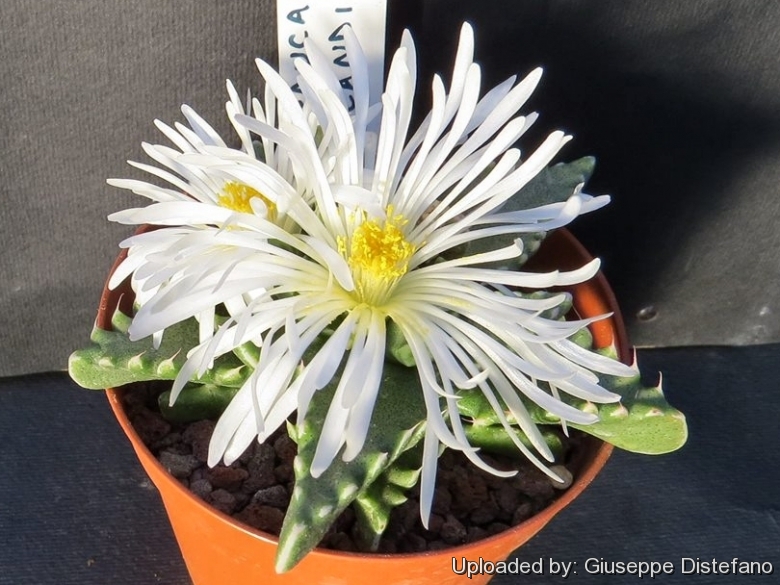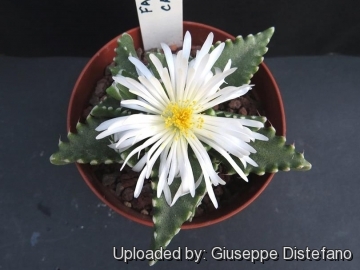Accepted Scientific Name: Faucaria felina Schwantes
Z. Sukkulentenk. ii. 177 (1926)

Faucaria candida Photo by: Giuseppe Distefano
Origin and Habitat: South Africa (Eastern Cape Province: Cradock)
Habitat: It grows in a primarily summer rainfall area in fine grained soils in grassy or shrubby vegetation types.
Synonyms:
See all synonyms of Faucaria felina
Description: The seldom mentioned Faucaria candidaSN|16589]]SN|16575]] is a distinctive form of Faucaria felinaSN|14721]]SN|16572]] with white or pinkish-white buds followed by large white flowers, in this normally yellow-flowered genus. The foliage is also somewhat different from others being more or less uniform bright green without tubercles or pale speckling though the margins are lined with pale, recurved teeth and the leaf apex bears a white to pinkish keel. However the differences with standard F. felina are very minimal and most botanist agree on the fact that both should all be included in the F. felina, and the two plants are not readily distinguishable, if not for the colouration of the flowers and uniform unspotted leaves. The F. candida is now just a white flowered form of the very variable F. felina.
Habit: It is a compact leaf succulent forming unusual clumps of fleshy, boat-shaped, toothed leaves. Although the variation in F. felina is great, as is reflected by the numerous synonyms, the species can be identified by the slender, spreading leaves with an oblique tip of the leaf. The lower number of teeth (which are shorter and not bristly) and the less conspicuous spotting separates the species from Faucaria tigrinaSN|16572]]SN|14721]], which also has more erect leaves. The name felina refers to the likeness of the leaves to the claws of a cat. The recurved leaf tubercles have very broad bases and look like cat's nails rather than teeth!
Stem Very reduced, tufted and developing a very short branched rhizomatous trunk with age.
Leaves: Up to 70 mm long, 5-20 mm broad, slender, spreading, rhomboidal, somewhat elongated, tapering gradually, keeled. Margins with 3-5 teeth in the upper half (rarely more or less); teeth broad, fleshy, curved, white or pink ending in papillate awns of 0,5 to 3 mm length. Faces of leaves green smooth, without tubercles or pale speckling, wax cover thin.
Flowers: Daisy-like up to 4 cm in diameter with 100-135 white petals, 210-320 stamens, glands green to brown; The flowers open only in full sunlight.
Blooming season: Late autumn to winter. The flowers open only in full sunlight.
Fruit: Base broadly bell-shaped, top with the valves often raised in the centre, 10-16 mm long, 9-11 mm in diameter.
Seeds: 1,4-1,5 mm broad.
Remarks: The even more rare Faucaria militarisSN|16575]]SN|16589]] is also a white flowered species.
Subspecies, varieties, forms and cultivars of plants belonging to the Faucaria felina group
 Faucaria candida L. Bolus: has large white flowers and leaves more or less uniform bright green without tubercles or pale speckling. Distribution: Cradock, Eastern Cape Province, South Africa.
Faucaria candida L. Bolus: has large white flowers and leaves more or less uniform bright green without tubercles or pale speckling. Distribution: Cradock, Eastern Cape Province, South Africa. Faucaria cradockensis L. Bolus: ((syn: Faucaria felina subs. felina) has long unspotted leaves with white or pink teeth. Distribution: Hill above Cradock, Somerset East Dist., Eastern Cape.
Faucaria cradockensis L. Bolus: ((syn: Faucaria felina subs. felina) has long unspotted leaves with white or pink teeth. Distribution: Hill above Cradock, Somerset East Dist., Eastern Cape. Faucaria felina Schwantes: has slender, spreading leaves with an oblique tip of the leaf. The lower number of teeth and the less spots separates it from Faucaria tigrina, which also has more erect leaves. Distribution: Eastern Cape-Province.
Faucaria felina Schwantes: has slender, spreading leaves with an oblique tip of the leaf. The lower number of teeth and the less spots separates it from Faucaria tigrina, which also has more erect leaves. Distribution: Eastern Cape-Province. Faucaria felina subs. britteniae (L. Bolus) L.E.Groen: has stouter whitish-grey green leaves, with darker-grey tiny dots, amd the keel meeting the upper leaf surface nearly at a right angle at the apex. Distribution: Albany, Grahamstown and Fort Beaufort, Eastern Cape.
Faucaria felina subs. britteniae (L. Bolus) L.E.Groen: has stouter whitish-grey green leaves, with darker-grey tiny dots, amd the keel meeting the upper leaf surface nearly at a right angle at the apex. Distribution: Albany, Grahamstown and Fort Beaufort, Eastern Cape. Faucaria felina subs. tuberculosa (Rolfe) L.E.Groen: Plant with large white tubercles or warts on upper leaf surface and soft white teeth along the edges. Cultivated plants shows a wide morphologic variability. Distribution: Bedford, Cape Province.
Faucaria felina subs. tuberculosa (Rolfe) L.E.Groen: Plant with large white tubercles or warts on upper leaf surface and soft white teeth along the edges. Cultivated plants shows a wide morphologic variability. Distribution: Bedford, Cape Province. Faucaria felina subs. tuberculosa cv. Super Warty: has large bumped and tangled tubercles or warts on upper leaf surface and soft white teeth along the edges. Origin: supposed from Japan.
Faucaria felina subs. tuberculosa cv. Super Warty: has large bumped and tangled tubercles or warts on upper leaf surface and soft white teeth along the edges. Origin: supposed from Japan. Faucaria longifolia L. Bolus: has long slender, more green leaves, keeled towards apex and with more numerous teeth. Distribution: Cape province.
Faucaria longifolia L. Bolus: has long slender, more green leaves, keeled towards apex and with more numerous teeth. Distribution: Cape province. Faucaria lupina (Haw.) Schwantes: has silvery green, long, triangular leaves, with fierce-looking teeth along the upper margin. Distribution: Uitenhage, Eastern Cape Province.
Faucaria lupina (Haw.) Schwantes: has silvery green, long, triangular leaves, with fierce-looking teeth along the upper margin. Distribution: Uitenhage, Eastern Cape Province. Faucaria speciosa L. Bolus: (syn: Faucaria felina subs. britteniae) has a more glaucous colour, and a rough leaf-surface. Distribution: Albany, Eastern Cape Province.
Faucaria speciosa L. Bolus: (syn: Faucaria felina subs. britteniae) has a more glaucous colour, and a rough leaf-surface. Distribution: Albany, Eastern Cape Province.
Bibliography: Major references and futher lectures
1) Doreen Court "Succulent Flora of Southern Africa" CRC Press, 01/giu/2000
2) Otto A. Leistner “Flora of southern Africa” 14: 194 1985
3) Jacobsen “Lexicon of succulent plants” Littlehampton Book Services Ltd. 1974
4) James Cullen, Sabina G. Knees, H. Suzanne Cubey "The European Garden Flora Flowering Plants: A Manual for the Identification of Plants Cultivated in Europe, Both Out-of-Doors and Under Glass" Cambridge University Press, 11/ago/2011
5) Dr J.P. Roux “Flora of South Africa” 2003
6) Domitilla Raimondo “Red list of South African plants 2009” South African National Biodiversity Institute, 2009
7) Werner Rauh “The Wonderful World of Succulents: Cultivation and Description of Selected Succulent Plants Other Than Cacti” Smithsonian Institution Press, 1984
8) Heidrun E. K. Hartmann "Illustrated Handbook of Succulent Plants: Aizoaceae F-Z" Springer, 2002
9) Ernst Van Jaarsveld, Ben-Erik Van Wyk, Gideon Smith "Succulents of South Africa: A Guide to the Regional Diversity" Tafelberg Publishers, Limited, 01/lug/2000
10) Gordon D. Rowley "The illustrated encyclopedia of succulents" Crown Publishers, 01/ago/1978
11) Clive Innes "Complete Handbook of Cacti and Succulents" Van Nostrand Reinhold Company, 01/dic/1981
 Faucaria candida Photo by: Giuseppe Distefano
Faucaria candida Photo by: Giuseppe Distefano Faucaria candida Photo by: Giuseppe Distefano
Faucaria candida Photo by: Giuseppe DistefanoCultivation and Propagation: Faucarias are the good choice for anyone wanting to start growing succulents. They are quite hardy and can take a short period of light frost and in very dry warm regions these succulents make very impressive out door ground covers. As house plants they tend to grow in fair weather and rest when temperatures are too hot or too cool.
Exposition: They need full sun to light shade , it should be protected from too much exposure in Summer. They do not do well in full shade as they tend to etiolate, fall over and rot easily.
Soil: It likes a well-drained soil mix, but can tolerate a wide variety of soil types and growing locations as long as there is plenty of sun.
Fertilization: The plants are fertilized only once during the growing season with a balanced fertilizer diluted to ½ the recommended strength.
Watering: This species is native to a primarily summer rainfall area but in cultivation the plant can be watered year-round. The plants are well watered during the growing season and allowed to dry thoroughly before watering again and will tolerate some over watering, but the challenge is to help them keep their compact form and prevent elongation of the stem. During the winter months, the plants should be kept quite dry, only watering enough to keep the leaves from shrivelling.
Pest & diseases: Faucarias are sensitive to mealybugs.
Rot: Rot is only a minor problem with Faucaria if the plants are watered and “aired” correctly. If they are not, fungicides won't help all that much. Care must be given in watering, keeping them warm and wet while growing, and cooler and dry when dormant.
Hardiness: Although the plants will survive mild frost if kept dry (hardy as low as -5° C) they should be protected from frost to prevent scarring. USDA 9b-12
Propagation: Faucaria is very easy to start from seed. Seeds germinate in 7-14 days at 21°C. Although they will start from cuttings, it is quite difficult to get them to root. If they start to rot there is usually part of the plant that can be removed and possibly rooted.













